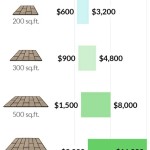How To Install Armstrong Laminate Flooring
Armstrong laminate flooring offers a durable and aesthetically pleasing alternative to hardwood, stone, or tile. Its ease of installation makes it a popular choice for both DIY enthusiasts and professional installers alike. Correct installation is crucial for ensuring the longevity, performance, and appearance of the flooring. This article provides a comprehensive guide to properly installing Armstrong laminate flooring, covering preparation, essential tools, and the step-by-step process.
Preparing for Laminate Flooring Installation
Prior to commencing the installation process, meticulous preparation is paramount. This phase involves assessing the existing subfloor, gathering necessary tools and materials, and acclimatizing the laminate flooring to the environment. Neglecting these preparatory steps can lead to installation complications and compromise the finished result.
Subfloor Evaluation and Preparation: The subfloor forms the foundation for the laminate flooring, and its condition directly impacts the stability and lifespan of the finished floor. The subfloor must be clean, level, and dry. Any imperfections must be addressed before proceeding. Common subfloor materials include concrete and plywood.
For concrete subfloors, conduct a moisture test using a concrete moisture meter or by taping plastic sheeting to the floor and checking for condensation after 24-48 hours. High moisture levels necessitate the application of a moisture barrier. Concrete subfloors also require leveling. Low spots can be filled with self-leveling compound, while high spots can be ground down. Ensure the concrete is free of debris, paint, and adhesive residue.
For plywood subfloors, inspect for signs of water damage, rot, or mold. Damaged sections must be replaced. Secure any loose subfloor panels with screws. Sand down any uneven surfaces or protruding nails. The plywood should be clean and dry before proceeding.
Acclimation of Laminate Flooring: Laminate flooring requires acclimation to the room's temperature and humidity levels prior to installation. This process allows the planks to expand or contract, minimizing the risk of gaps or buckling after installation. Store the unopened boxes of laminate flooring in the room where they will be installed for at least 48 to 72 hours. Maintain a consistent temperature between 65°F and 75°F and a humidity level between 30% and 50%.
Gathering Tools and Materials: Having all the necessary tools and materials readily available streamlines the installation process. Essential tools include:
- Measuring Tape: For accurate measurements of the room and planks.
- Pencil: For marking cut lines.
- Circular Saw or Laminate Cutter: For precise cuts of the laminate planks.
- Jigsaw: For making intricate cuts around doorways, pipes, and other obstacles.
- Rubber Mallet: For gently tapping planks together to create a tight fit.
- Tapping Block: Protects the edge of the laminate plank while tapping.
- Pull Bar: Used to tighten the final row of planks against the wall.
- Spacers: To maintain a consistent expansion gap around the perimeter of the room.
- Underlayment: Provides a moisture barrier, sound insulation, and a smoother surface for the laminate flooring.
- Moisture Meter: To measure the moisture content of subfloors.
- Safety Glasses: To protect eyes from debris.
- Knee Pads: For comfort during installation.
Appropriate safety gear is essential throughout the installation process. Wear safety glasses to protect eyes from dust and debris generated during cutting. Knee pads provide comfort and protect knees during extended periods of kneeling. A dust mask can protect against airborne dust.
Laying the Foundation: Underlayment Installation
The underlayment serves a multifaceted purpose in laminate flooring installation. It acts as a moisture barrier, providing protection against moisture emanating from the subfloor. It also enhances sound insulation, reducing noise transmission. Furthermore, it creates a smoother surface for the laminate flooring, minimizing imperfections and ensuring a level installation.
Roll out the underlayment across the prepared subfloor, ensuring it covers the entire area. Overlap the edges of the underlayment by a few inches and secure them with moisture-resistant tape. This overlap creates a continuous moisture barrier. Trim any excess underlayment along the walls using a utility knife.
Ensure the underlayment is smooth and free of wrinkles or bubbles. Secure it to the subfloor with tape if necessary. The underlayment should provide a stable and level base for the laminate flooring.
Installing the Laminate Flooring
With the subfloor prepared and the underlayment installed, the installation of the laminate flooring can commence. This process requires careful attention to detail to ensure a proper fit and a visually appealing result.
Planning the Layout: Before starting, plan the layout of the laminate flooring. Determine the direction the planks will run, considering the dimensions of the room and the location of doorways and other features. Optimizing the layout can minimize waste and create a more aesthetically pleasing appearance.
Begin by dry-laying a few rows of planks without clicking them together. This allows for visual assessment and adjustments to the layout. Ensure the first row is straight and aligned with the starting wall. Use spacers along the wall to maintain the recommended expansion gap, typically ¼ to ⅜ inch. This gap allows for natural expansion and contraction of the flooring without causing buckling.
Clicking the Planks Together: Armstrong laminate flooring typically utilizes a click-lock system. This system allows for easy and secure interlocking of the planks without the need for glue or nails. Begin by aligning the first plank with the starting wall, using spacers to maintain the expansion gap. Angle the end of the second plank into the end of the first plank at a slight angle. Gently press down until the planks click together. Ensure the seam is tight and flush.
Continue adding planks to the first row, clicking them together end-to-end. Use a tapping block and rubber mallet to gently tap the planks together if necessary. Avoid excessive force, which can damage the locking mechanism. Once the first row is complete, proceed to the second row.
Stagger the seams between rows to create a more natural look and enhance the stability of the floor. Typically, the end joint of the first plank in the second row should be at least 6 inches away from the end joint of the first plank in the first row. Cut the first plank of the second row to the appropriate length using a circular saw or laminate cutter. Repeat the process of clicking the planks together, ensuring the side seams are tightly interlocked.
Dealing with Obstacles: During the installation process, obstacles such as doorways, pipes, and corners will require special attention. Measure the distance from the wall to the obstacle and transfer these measurements to the laminate plank. Use a jigsaw to cut the plank to fit around the obstacle. For pipes, use a hole saw to create a circular opening in the plank. Ensure the opening is slightly larger than the diameter of the pipe to allow for expansion.
For doorways, consider undercutting the door jambs and casing to allow the laminate flooring to slide underneath. This creates a cleaner and more professional look. Use a jamb saw to undercut the door jambs to the appropriate height. Carefully measure and cut the laminate plank to fit snugly around the door jamb.
Installing the Final Row: Installing the final row of laminate flooring can be challenging, as it often requires cutting the planks to fit the remaining space while maintaining the expansion gap. Measure the distance from the wall to the last installed row at several points. Transfer these measurements to the laminate plank, ensuring to account for the expansion gap. Use a circular saw or laminate cutter to cut the plank to the appropriate width.
Use a pull bar to tighten the final row of planks against the wall. Place the pull bar against the wall and use a rubber mallet to gently tap the planks into place. The pull bar provides leverage and allows for a tight fit even in tight spaces.
Finishing Touches: Trim and Transitions
The final stage of laminate flooring installation involves adding trim and transitions to complete the look and provide a seamless finish. Trim covers the expansion gap along the walls and transitions connect the laminate flooring to other flooring types.
Installing Baseboards and Quarter Round: Baseboards and quarter round trim are used to cover the expansion gap along the walls. Measure and cut the trim to fit the perimeter of the room. Use a miter saw to create angled cuts for corners. Attach the trim to the wall using finishing nails or construction adhesive. Ensure the trim is securely fastened and covers the expansion gap completely.
Installing Transition Strips: Transition strips are used to connect the laminate flooring to other flooring types, such as tile, carpet, or hardwood. Choose a transition strip that matches the height and style of the laminate flooring. Install the transition strip according to the manufacturer's instructions. Typically, the transition strip is attached to the subfloor using screws or adhesive. Ensure the transition strip is level and provides a smooth transition between the different flooring types.
Inspect the completed installation for any imperfections or gaps. Address any issues promptly. Clean the laminate flooring with a damp cloth to remove any dust or debris. Following these instructions will ensure a successful Armstrong laminate flooring installation.

Installing Armstrong Laminate Flooring

Armstrong Laminate Flooring Installation Instructions

Laminate Floor Installation Armstrong Flooring

Installing Armstrong Laminate Flooring

Installing Armstrong Laminate Flooring

How To Install Laminate Flooring The Lilypad Cottage

How To Install Laminate Flooring Shanty 2 Chic

10 Steps For Installing Laminate Flooring Lv Hardwood Toronto

How To Install Laminate Flooring Shanty 2 Chic

How To Install Laminate Flooring
Related Posts








